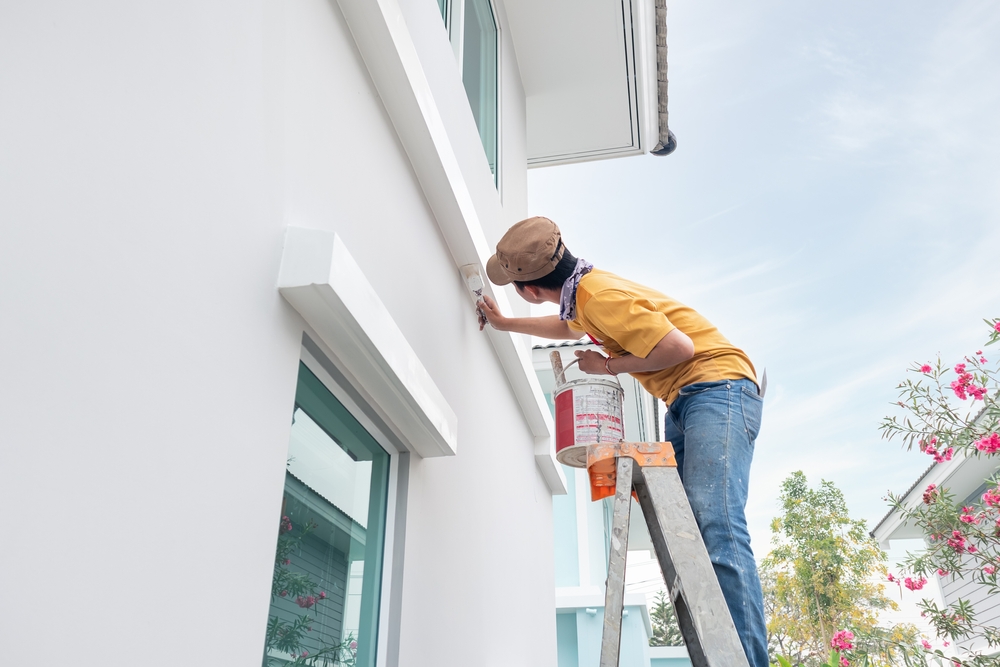15 Hacks to Avoid Common Mistakes of Exterior Home Painting

Painting your home’s exterior can revive the whole vibe with its curb appeal & renewed protection. But it also brings a wave of questions: What paint should I choose? Do I need to prep extensively? Can I DIY the whole thing? All the worries are real and valid.
Because a sloppy paint job looks worse than no paint at all. Plus, it fails quickly, meaning wasted effort and cash.
At Final Touch Paint & Decor, we’ve repainted hundreds of Perth homes and commercial properties with top-tier routes, materials, and eco-conscious paints. We get how tricky exterior painting in our heat and sun can be. And we know how to deal with it.
So, let’s teach you some tips and tricks of exterior home painting.
Tips for Painting the Exterior of Your Home Like A Pro
Here are some tried and tested exterior home painting ideas, from prep to final finishes.
1. Gather All Essential Painting Materials
For a smooth process, you need to make a checklist and gather everything before starting. The toolkit should include essentials like:
- High-quality exterior paint (with suitable colour and finish)
- Filler and filling knife
- Sandpaper, wire brushes, scrapers
- Primer suited for external surfaces
- Variety of brushes and rollers (angled brushes & 9″ rollers)
- Sponge & soap
- Paint trays and liners
- Masking tape
- Drop sheets, tarps or plastic sheeting
- Stir sticks and a paint mixer
- Protective gloves, eyewear, respirator mask
- Ladder or scaffolding
- Filler compound for cracks
- Bucket (for mixing paint or cleaning)
- Rubber mallet to seal paint tins
Having everything within reach keeps the project flowing smoothly. So, you don’t have to run back to the store mid-job.
2. Invest Time in Thorough Surface Preparation
Most people ignore it, but trust us, this is the make-or-break step. A paint job is only as good as its prep work. Some recommended steps are:
- Thorough cleaning: Use a pressure washer or hose with detergent to remove grime, mildew, bird droppings, and surface dust.
- Scraping and sanding: Scrape away all flaked or peeling paint. Sand glossy surfaces to improve adhesion.
- Repairing damage: Fill cracks, holes or rotten wood with exterior filler. Replace wood sections if needed.
- Surface testing: Tap the surfaces, and check for hollow sounds as they indicate decay beneath. Have them repaired.
- Drying: Let surfaces dry for 48 hours (weather dependent) before proceeding with primer.
Done right, this preparation will extend your paint’s life considerably.
3. Check Weather Timing Carefully
Exterior painting is all about timing. To avoid the weather-related damages, you should:
- Choose days with light cloud cover and 10–25°C temperature.
- Avoid painting in high humidity, strong winds, or upcoming rain.
- Avoid direct sunlight as it can cause premature drying and visible brush strokes. Paint in morning or late afternoon.
- Monitor the weather forecast 2–3 days ahead. Even a sudden mist within 24 hours can ruin new paint.
Right timing helps the paint cure properly and prevents unsightly marks.
4. Repair Rotten or Damaged Surfaces First
Painting over damage only hides the real issue and soon it will cause your paint to peel off. Inspect your cladding, trim, fascia, decks, fences and windows for:
- Rotten wood, termite damage or weakness
- Cracks and splits
- Mould or mildew
Replace damaged sections & use treated timber or rot-resistant wood where possible. You can also wood hardener and filler in the damaged area. In Perth’s climate, we always recommend rust-inhibiting primers on bare wood before painting.
5. Protect Landscaping and Outdoor Fixtures
Prevent accidental damage and mess by:
- Covering plants, flowerbeds, paving, decks, patios, bins, furniture, or outdoor heaters.
- Securing covers with tape or weights if wind is likely.
- Using boards under ladders to protect grass or decking.
- Covering the light switches, power outlets, house numbers & vents.
Proper coverage avoids costly clean-ups or plant damage down the line.
6. Mask Edges for Crisp Lines
Painter’s tape is your best friend for cleaner edges and minimal mess. Apply it to:
- Window frames
- Door trims
- Eaves and fascia
- Light fixtures and vents
- Colour transition zones (e.g. where walls meet brickwork)
Press the edges firmly and remove the tape at a 45° angle when the paint is still tacky. It’ll prevents peeling and gives sharper lines.
7. Use Scaffolding or Safe Ladders
Painting higher exterior areas safely requires proper access. You’ll need:
- Secure ladders with stabilisers
- Scaffolding or a ladder platform for 2-storey homes
- Proper footwear (non-slip and dust-proof)
- Safety gear like gloves, eyewear, respirators, and harnesses
Never overreach from your ladder, instead move it to keep your base stable. We’ll recommend scaffolds as a preferred choice because moving the ladders and carrying paint up and down is a dangerous job.
8. Choose the Right Paint for the Job
Decide between:
- Water-based (acrylic): quicker dry time, easier cleanup, low‑VOC, more adhesion.
- Oil-based: tougher, penetrates wood better, longer drying times, stronger VOCs.
Consider the weather exposure and material of your house (timber, metal, render, brick). Also decide finishing type (matte, satin, gloss). If you care about environmental impact, choose eco friendly painting Perth range.
9. Check Colour and Quality with a Patch Test
You can’t be sure of a paint’s quality unless you see it yourself. So, before starting the process, always:
- Paint a 1m² test patch
- Observe how the colour shifts at different times and light conditions
- Note how it handles surface texture and humidity
- See if wet edges stand out and how shine looks when dry
You can change anything at this point before committing to the entire façade.
10. Use Primer for Longevity and Uniformity
A quality primer will save the paint quality & enhance its durability. Benefits include:
- Seals porous surfaces to prevent uneven colour
- Blocks stains or discolouration from wood or previous paint
- Gives better adhesion and smooth coverage of finish paint
Match primer type to substrate (wood, masonry, metal). Let it cure according to instructions before finishing coats.
11. Mix-up Paint Batches for Consistent Colour
Even identical tins can vary in colour and affect the uniformity of the painted surface. Plus, the small quantities will empty soon and interrupt the process. The smart move:
- Pour all finish paint cans into one large bucket
- Mix thoroughly (boxing)
- Stir before you start and every hour thereafter
Every professional painter does it to prevent streaks or tone variations on the walls.
12. Apply Paint from Edges to Mid & Top to Bottom
If you want to get smoother results, follow best practices in technique.
- Cut in narrowly along edges (trim, windows) using an angled brush
- Use a roller for wall flats, working in small sections (2m² at a time)
- Roll top to bottom with a slight overlap for even coverage
- Backroll right away to even out texture and shine
- Keep an even wet edge to avoid lap marks
- Work in smaller sections
These tricks will help manage the consistency of paint.
13. Wait for Proper Drying Before Adding the Next Coat
Always remember that rushing the process will give you nothing but guilts. So, don’t go for shortcuts, instead:
- Read the paint tin as drying times vary per brand/type
- Consider the weather too, sun speeds up the drying & cool damp slows it down
- Wait 4–8 hours between coats, or up to 24 in cool conditions
Skipping the drying time will lead to bubbling, flaking or cracking later on.
14. Seal Paint Tins Tight to Save Leftover Paint
To keep paint fresh and usable, always:
- Press the lid down after the session of painting
- Close it with a rubber mallet, not a hammer to avoid deforming it.
- Store cans upright, in a sealed plastic bag to avoid rust.
- Keep them in a cool, dry space as temperature extremes ruin the paint.
- Label each can with the colour, brand, batch number and date.
Always keep some extra unopened paint cans for easy touch-ups if damage shows up later.
15. Consider the Experts for a Top-Quality Finish
DIY is feasible, but the things can get messy if you don’t have enough experience or professional tools. You can always hire the pros for:
- Consultation to choose exterior home painting colours
- Precise, consistent workmanship on prepping, priming, painting
- Full safety setup and efficient scaffolding use
- High-grade & eco-friendly materials
- Guaranteed results with a spotless finish and protected landscaping
Professional house painting gives you reliability, quality workmanship with zero mess.
Exterior Home Painting Cost
Okay, so now let’s talk about how much the process will cost you.
Exterior painting isn’t a small job, and the price can vary significantly based on a range of factors. E.g. The size of your home, number of storeys, and condition of the surfaces. If your walls are cracked, peeling, or uneven, the prep work alone can cost you fortune.
If you’re thinking of DIY to save money, keep in mind that buying all the gear and tools can end up costing more. Plus, the quality won’t match professional painting and you have to redo it in a couple of years.
On the other hand, professional house painters Perth offer all-inclusive quotes that cover prep, paint, tools, safety, and clean-up. And the results that last longer and look better.
Searching for Best Exterior Home Painting in Reasonable Price?
Contact Final Touch Paint & Décor for Professional Results
We bring 30+ years of crafty, eco-conscious painting across Perth homes.
Our professional painters will tackle the setup, colour advice, prep, painting, and final clean-up, with care and precision. If you want subtle elegance or bold change, our crew is ready to make it happen.
We’ll walk you through options, timeline, and pricing for an honest start.
